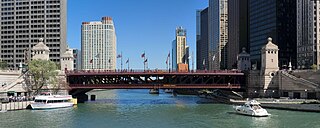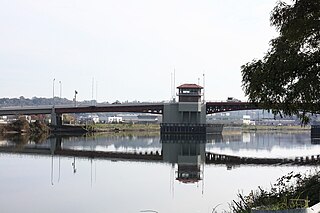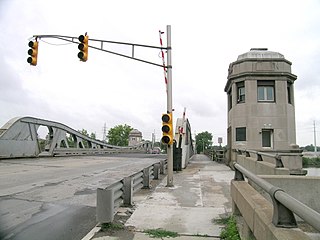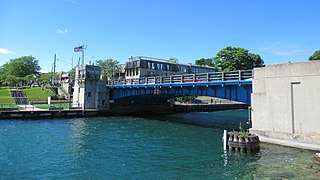
The street layout of Seattle is based on a series of disjointed rectangular street grids. Most of Seattle and King County use a single street grid, oriented on true north. Near the center of the city, various land claims were platted in the 19th century with differently oriented grids, which still survive today. Distinctly oriented grids also exist in some cities annexed by Seattle in the early 20th century, such as Ballard and Georgetown. A small number of streets and roads are exceptions to the grid pattern.

State Route 99 (SR 99), also known as the Pacific Highway, is a state highway in the Seattle metropolitan area, part of the U.S. state of Washington. It runs 49 miles (79 km) from Fife to Everett, passing through the cities of Federal Way, SeaTac, Seattle, Shoreline, and Lynnwood. The route primarily follows arterial streets, including Aurora Avenue, and has several freeway segments, including the tolled SR 99 Tunnel in Downtown Seattle. SR 99 was officially named the William P. Stewart Memorial Highway by the state legislature in 2016, after a campaign to replace an unofficial moniker honoring Confederate president Jefferson Davis.

The Fremont Bridge is a double-leaf bascule bridge that spans the Fremont Cut in Seattle, Washington. The bridge, which connects Fremont Avenue North and 4th Avenue North, connects the neighborhoods of Fremont and Queen Anne.

The Montlake Bridge is a double-leaf bascule bridge that carries State Route 513 over Seattle's Montlake Cut—part of the Lake Washington Ship Canal—connecting Montlake and the University District.

The Aurora Bridge is a cantilever and truss bridge in Seattle, Washington, United States. It carries State Route 99 over the west end of Seattle's Lake Union and connects Queen Anne and Fremont. The bridge is located just east of the Fremont Cut, which itself is spanned by the Fremont Bridge.

The Alaskan Way Viaduct was an elevated freeway in Seattle, Washington, United States, that carried a section of State Route 99. The double-decked freeway ran north–south along the city's waterfront for 2.2 miles (3.5 km), east of Alaskan Way and Elliott Bay, and traveled between the West Seattle Freeway in SoDo and the Battery Street Tunnel in Belltown.

The Broadway Bridge is a Rall-type bascule bridge spanning the Willamette River in Portland, Oregon, United States, built in 1913. It was Portland's first bascule bridge, and it continues to hold the distinction of being the longest span of its bascule design type in the world. It was added to the National Register of Historic Places in November 2012.

The West Seattle Bridge, officially the Jeanette Williams Memorial Bridge, is a cantilevered segmental bridge that serves as the primary connection between West Seattle and important highways such as State Route 99, the Spokane Street Viaduct, and Interstate 5. It was built between 1981 and 1984 after the previous bascule bridge was deemed inoperable as a result of being struck by the freighter Antonio Chavez in 1978.

The DuSable Bridge is a bascule bridge that carries Michigan Avenue across the main stem of the Chicago River in downtown Chicago, Illinois, United States. The bridge was proposed in the early 20th century as part of a plan to link Chicago's south side and north side parks with a grand boulevard. Construction of the bridge started in 1918, it opened to traffic in 1920, and decorative work was completed in 1928. The bridge provides passage for vehicles and pedestrians on two levels. An example of a fixed trunnion bascule bridge, it may be raised to allow tall ships and boats to pass underneath. The bridge is included in the Michigan–Wacker Historic District and has been designated as a Chicago Landmark.

The North Avenue Bridge can refer to one of three bridges that has carried North Avenue over the North Branch of the Chicago River on the north side of Chicago, Illinois. A center-pier swing bridge built in 1877 was replaced in 1907 by a bascule bridge, allowing river traffic more room for maneuvering in and out of the North Canal, just north of Goose Island.

The South Park Bridge is a Scherzer rolling lift double-leaf bascule bridge in Seattle, Washington, United States. The bridge is operated by the King County government, It carries automobile traffic over the Duwamish River near Boeing Field, just outside the city limits of Seattle, and is named for the nearby South Park neighborhood of Seattle. It was listed on the National Register of Historic Places in 1982, as the 14th Avenue South Bridge.

The Spit Bridge, a steel and concrete girder bridge with a bascule lift span across the Middle Harbour, is located 10 kilometres (6.2 mi) north-east of the central business district in Sydney, Australia. The bridge carries The Spit Road (A8) from a point called The Spit, and connects the suburbs of Mosman, on the south bank and Seaforth, on the north bank.

The West Jefferson Avenue–Rouge River Bridge is a bridge located where Jefferson Avenue crosses the Rouge River at the border of Detroit and River Rouge, Michigan. It is the only surviving pony truss bascule bridge in the state of Michigan. It was listed on the National Register of Historic Places in 2000.

The US 31–Island Lake Outlet Bridge is a double-leaf bascule bridge in downtown Charlevoix in the U.S. state of Michigan. The bridge carries U.S. Highway 31 across Island Lake Outlet that ultimately connects Lake Charlevoix to Lake Michigan.

The Cheboygan Bascule Bridge, also known as the State Street Bridge, is a double-leaf bascule bridge in Cheboygan, Michigan, carrying U.S. Highway 23 across the Cheboygan River. Built in 1940, it was the last bascule bridge constructed in the state of Michigan prior to the end of World War II. It replaced an aging swing bridge built in 1877. The bridge is listed on the National Register of Historic Places.

The Grand Street Bridge was a double-leaf deck-girder bascule bridge in Bridgeport, Connecticut, United States, that spanned the Pequonnock River and connected Grand Street and Artic Street. It was one of three movable bridges planned by the City of Bridgeport in 1916 at the request of the War Department during World War I. Construction was completed in 1919, but the delays surrounding the construction went to the Connecticut Supreme Court in case of Edward DeV. Tompkins, Inc. vs. City of Bridgeport, Connecticut. The court ruled in favor of Tompkins and awarded damages equal to the contract. In 1936, the bridge had excessive settling and required the replacement of its southeast pier. As part of the repairs, a new floor and electrical system were installed. In 1965, the floor was replaced with a steel grate on I-beam floor. In 1984, the eastern approach span was replaced and the northwest trunnion post was reconstructed. The bridge was closed in the 1990s and dismantled in 1999.

The West Spokane Street Bridge was a pair of bascule bridges that crossed the west fork of the Duwamish River in Seattle, Washington, United States. The bridges connected the SoDo and West Seattle neighborhoods over the river. The original bridge opened to traffic in 1924; a second bridge carrying eastbound traffic was opened in 1930, with the 1924 bridge reconfigured to carry westbound traffic.

The Fairview Avenue North Bridge is a road bridge in the Eastlake neighborhood of Seattle, Washington, United States, crossing a shallow arm of Lake Union. The original timber-pile bridge was built in 1948 and expanded with a concrete span in 1963. Both bridges were replaced by a new span that opened in 2021.

The Barra Strait Bridge is a Canadian road bridge crossing the Barra Strait of Bras d'Or Lake, carrying Nova Scotia Route 223 between Iona, Victoria County, on the West side, and Grand Narrows, Cape Breton County on the east side. The bridge incorporates a double leaf bascule section at its eastern end to permit the continued passage of marine traffic through the strait.
























